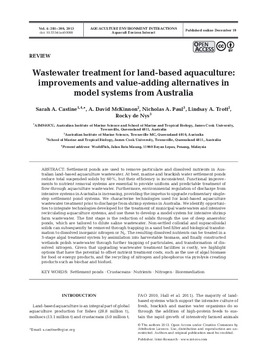Please use this identifier to cite or link to this item:
https://hdl.handle.net/20.500.12348/885
Wastewater treatment for land-based aquaculture: improvements and value-adding alternatives in model systems from Australia

Abstract
- Settlement ponds are used to remove particulate and dissolved nutrients in Australian land-based aquaculture wastewater. At best, marine and brackish water settlement ponds reduce total suspended solids by 60%, but their efficiency is inconsistent. Functional improvements to nutrient removal systems are essential to provide uniform and predictable treatment of flow-through aquaculture wastewater. Furthermore, environmental regulation of discharge from intensive systems in Australia is increasing, providing the impetus to upgrade rudimentary single-step settlement pond systems. We characterise technologies used for land-based aquaculture wastewater treatment prior to discharge from shrimp systems in Australia. We identify opportunities to integrate technologies developed for the treatment of municipal wastewaters and intensive recirculating aquaculture systems, and use these to develop a model system for intensive shrimp farm wastewater. The first stage is the reduction of solids through the use of deep anaerobic ponds, which are tailored to dilute saline wastewater. Non-settled colloidal and supracolloidal solids can subsequently be removed through trapping in a sand bed filter and biological transformation to dissolved inorganic nitrogen or N2. The resulting dissolved nutrients can be treated in a 3-stage algal treatment system by assimilation into harvestable biomass, and finally constructed wetlands polish wastewater through further trapping of particulates, and transformation of dissolved nitrogen. Given that upgrading wastewater treatment facilities is costly, we highlight options that have the potential to offset nutrient treatment costs, such as the use of algal biomass for food or energy products, and the recycling of nitrogen and phosphorus via pyrolysis creating products such as biochar and biofuel.
Collections
- Sustainable aquaculture [2738]
View/
Date
- 2013
Author
-
Castine, S.
-
McKinnon, A.D.
-
Paul, N.A.
-
Trott, L.A.
-
de Nys, R.
AGROVOC Keywords
Type
- Journal Article
Publisher
- Inter-Research Science Center
